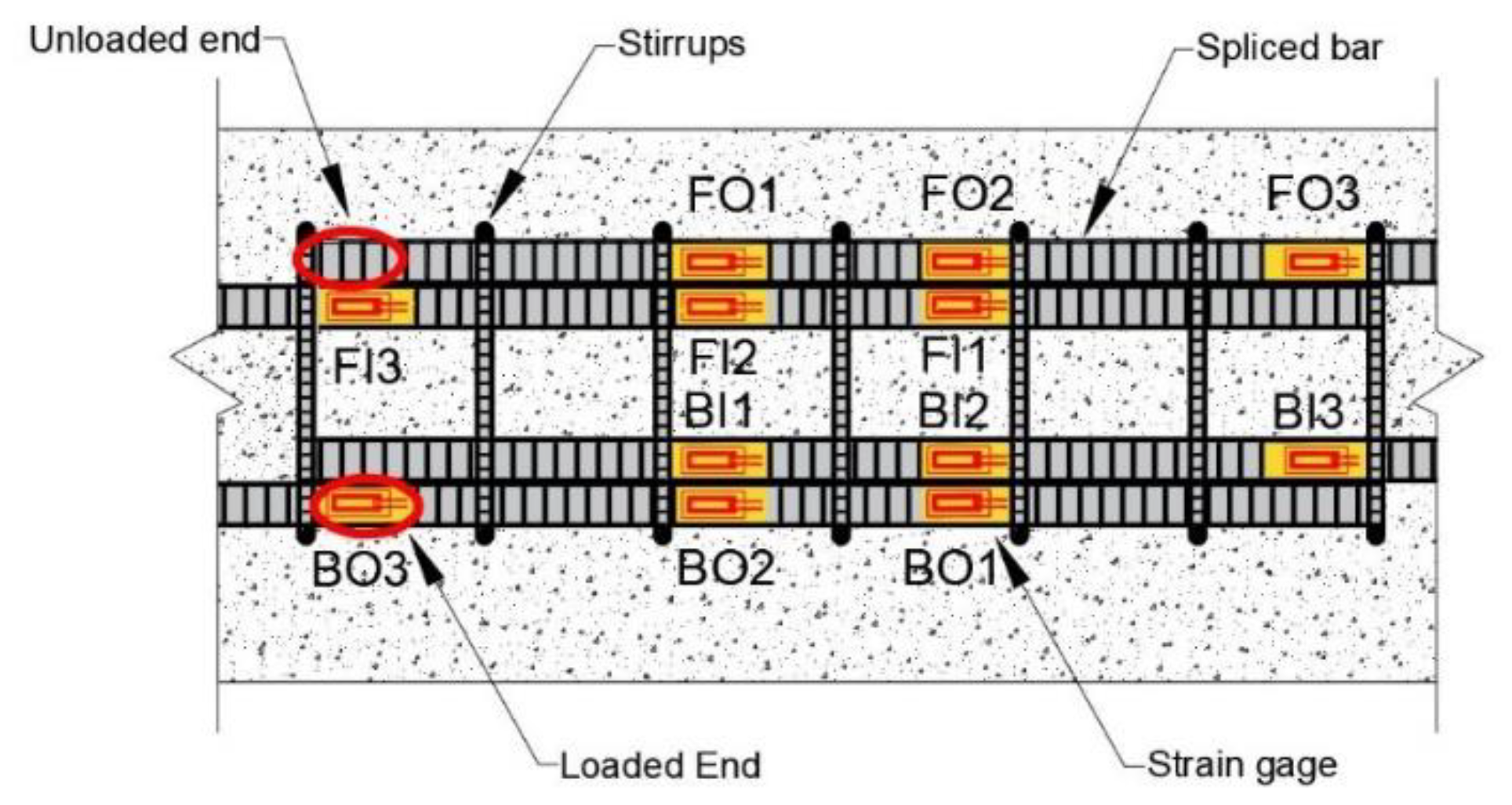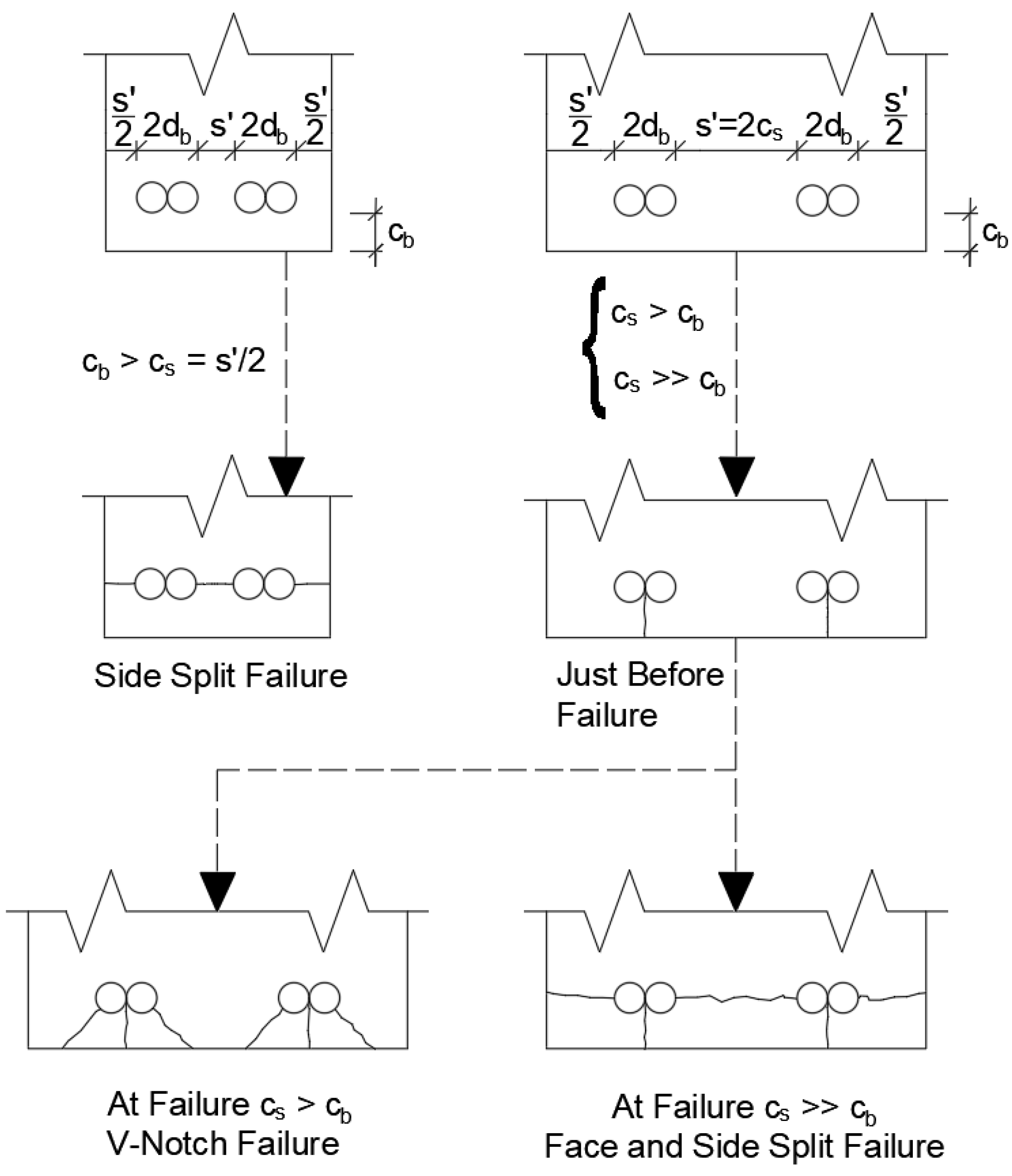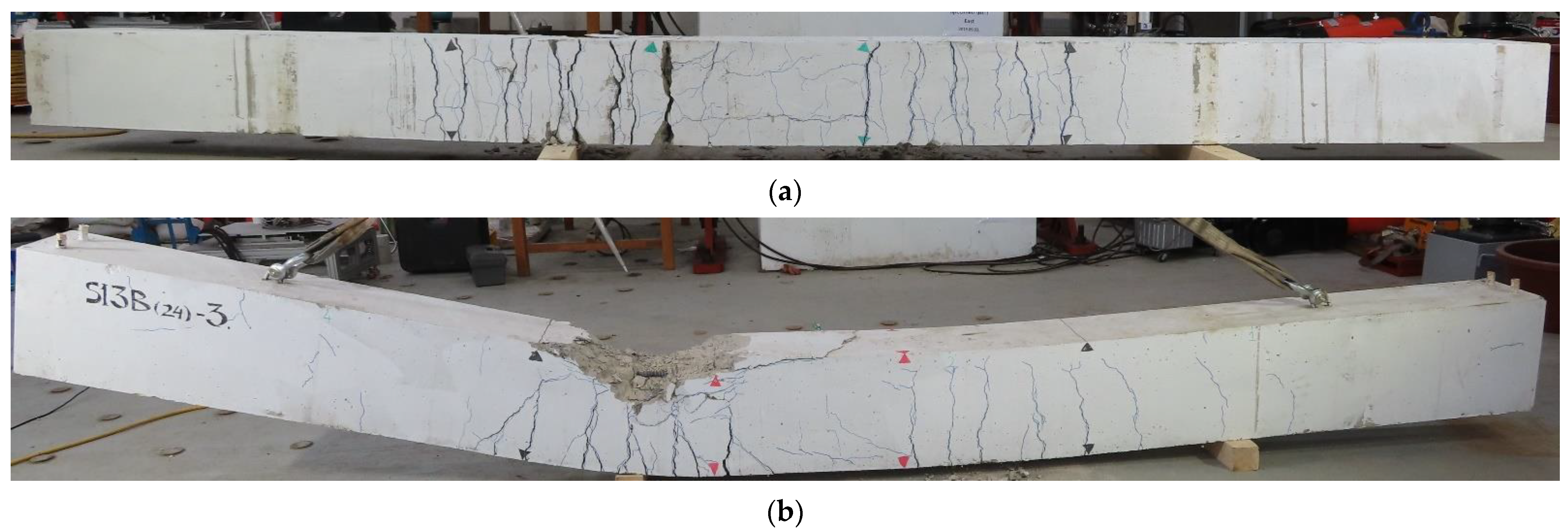Local Behavior of Lap-Spliced Deformed Rebars in Reinforced Concrete Beams
Abstract
:1. Introduction
2. Specimen Details
3. Test Setup
4. Test Result and Discussion
4.1. Failure Mode
4.2. Cracking Pattern Accordng to Failure Mode
4.3. Strain in Lap-Spliced Rebars
4.4. Initial Stiffness, K
4.5. Ductility, µ
4.6. Energy Dissipation, E
4.7. Bond Strength
5. Conclusions
- As supported by previous literature, strain gauge data shows that strain is maximum at the loaded end of a lap splice and progressively decreases toward the unloaded end.
- Beams without sufficient lap splice length fail in a brittle manner (bond failure). For these specimens, the increase in strain with displacement at all gauge points is almost linear. Then, after reaching a peak value, the strain drops, indicating the initiation of bond loss.
- Beams with sufficient lap splice length fail in a ductile manner (yield failure). For these beams, rebar yielding occurs at the loaded end of the lap splice and causes stress redistribution. Concrete in the compression region is crushed on one side from midspan after reaching the peak load. This remarkably increases the asymmetric behavior of beam specimens such that bar strains increase at the crushed section but decrease on the opposite side of midspan. Yield failure specimens as compared to bond failure beams exhibit approximately 10 and 8.5 times greater ductility and energy dissipation, respectively.
- The bond strengths of our specimens, which undergo bond failure, are compared with the bond strength values yielded by the three empirical equations proposed by Orangun et al. (1977) [2], Darwin et al. (1995) [22], and Esfahani and Kianoush (2005) [30]. The comparison indicates that these equations yield a satisfactory prediction of results. In particular, equation suggested by Orangun et al. [2] yields the best prediction.
Author Contributions
Funding
Institutional Review Board Statement
Informed Consent Statement
Data Availability Statement
Conflicts of Interest
References
- Orangun, C.; Jirsa, J.O.; Breen, J. The Strength of Anchor Bars: A Reevaluation of Test Data on Development Length and Splices; Research Report No. 154-3F; Center for Transportation Research, The University of Texas at Austin: Austin, TX, USA, 1975; p. 194. [Google Scholar]
- Orangun, C.; Jirsa, J.; Breen, J. A reevaulation of test data on development length and splices. ACI J. Proc. 1977, 74, 114–122. [Google Scholar]
- ACI Committee 318. Building Code Requirements for Structural Concrete and Commentary (ACI 318–95); American Concrete Institute: Farmington Hills, MI, USA, 2008; p. 369. [Google Scholar]
- Reynolds, G. Bond Strength of Deformed Bars in Tension; Proc. of the Symposium on Concrete; IEAust: Perth, Australia, 1982; Volume 83, pp. 65–69. [Google Scholar]
- Morita, S.; Fujii, S. Bond capacity of deformed bars due to splitting of surrounding concrete. Bond Concr. 1982, 331, 41. [Google Scholar]
- Lukose, K.; Gergely, P.; White, R. Behavior of reinforced concrete lapped splices for inelastic cyclic loading. J. Proc. 1982, 79, 355–365. [Google Scholar]
- Panashahi, N.; White, R.N.; Gergely, P. Reinforced concrete compression lap splices under inelastic cyclic loading. Struct. J. 1992, 89, 164–175. [Google Scholar]
- Azizinamini, A.; Chisala, M.; Ghosh, S. Tension development length of reinforcing bars embedded in high-strength concrete. Eng. Struct. 1995, 17, 512–522. [Google Scholar] [CrossRef]
- Azizinamini, A.; Pavel, R.; Hatfield, E.; Ghosh, S.K. Behavior of lap-spliced reinforcing bars embedded in high-strength concrete. Struct. J. 1999, 96, 826–835. [Google Scholar]
- Rakhshanimehr, M.; Esfahani, M.R.; Kianoush, M.R.; Mohammadzadeh, B.A.; Mousavi, S.R. Flexural ductility of reinforced concrete beams with lap-spliced bars. Can. J. Civ. Eng. 2014, 41, 594–604. [Google Scholar] [CrossRef]
- Abdel-Kareem, A.H.; Abousafa, H.; El-Hadidi, O.S. Effect of transverse reinforcement on the behavior of tension lap splice in high-strength reinforced concrete beams. Int. J. Bioeng. Life Sci. 2014, 7, 989–996. [Google Scholar]
- Mousa, M.I. Flexural behaviour and ductility of high strength concrete (HSC) beams with tension lap splice. Alex. Eng. J. 2015, 54, 551–563. [Google Scholar] [CrossRef]
- Plizzari, G.A.; Marchina, E.; Giuriani, E. Experimental study of splitting and flexural cracks in a RC beam with overlapped splices. Mater. Struct. 1996, 29, 19–27. [Google Scholar] [CrossRef]
- Cohn, M.; Bartlett, M. Computer-simulated flexural tests of partially prestressed concrete sections. J. Struct. Div. 1982, 108, 2747–2765. [Google Scholar] [CrossRef]
- Hassan, M.N.; Feldman, L.R. Behavior of Lap-Spliced Plain Steel Bars. ACI Struct. J. 2012, 109, 235–243. [Google Scholar]
- Garcia, R.; Helal, Y.; Pilakoutas, K.; Guadagnini, M. Bond behaviour of substandard splices in RC beams externally confined with CFRP. Constr. Build. Mater. 2014, 50, 340–351. [Google Scholar] [CrossRef] [Green Version]
- Wu, C.; Chen, G.; Volz, J.S.; Brow, R.K.; Koenigstein, M.L. Global bond behavior of enamel-coated rebar in concrete beams with spliced reinforcement. Constr. Build. Mater. 2013, 40, 793–801. [Google Scholar] [CrossRef]
- Garcia, R.; Helal, Y.; Pilakoutas, K.; Guadagnini, M. Bond strength of short lap splices in RC beams confined with steel stirrups or external CFRP. Mater. Struct. 2015, 48, 277–293. [Google Scholar] [CrossRef]
- Gaurav, G.; Singh, B. Experimental investigation of bond behavior with tension lap splice for deformed steel bars in recycled aggregate concrete. J. Sustain. Cem. -Based Mater. 2018, 7, 99–121. [Google Scholar] [CrossRef]
- Mahmoud, A.; Hatem, E.; Hassanean, Y.; Megahid, A. FLEXURAL BEHAVIOR OF LAPPED SPLICED HIGH STRENGTH RC BEAMS SUBJECTED TO STATIC LOADING. JES. J. Eng. Sci. 2006, 34, 395–411. [Google Scholar]
- Mabrouk, R.T.; Mounir, A. Behavior of RC beams with tension lap splices confined with transverse reinforcement using different types of concrete under pure bending. Alex. Eng. J. 2018, 57, 1727–1740. [Google Scholar] [CrossRef]
- Darwin, D.; Tholen, M.L.; Idun, E.K.; Zuo, J. Splice Strength of High Relative Rib Area Reinforcing Bars; University of Kansas Center for Research, Inc.: Lawrence, Kansas, 1995. [Google Scholar]
- Darwin, D.; Zuo, J.; Tholen, M.L.; Idun, E.K. Development Length Criteria for Conventional and High Relative Rib Area Reinforcing Bars; University of Kansas Center for Research, Inc.: Lawrence, Kansas, 1995. [Google Scholar]
- ACI Committee 408. Bond and Development of Straight Reinforcing Bars in Tension (ACI 408R-03); American Concrete Institute: Farmington Hills, MI, USA, 2003; p. 49. [Google Scholar]
- Zuo, J.; Darwin, D. Splice Strength of Conventional and High Relative Rib Area Bars in Normal and High-Strength Concrete; American Concrete Institute: Farmington Hills, MI, USA, 2000. [Google Scholar]
- Esfahani, M.R.; Rangan, B.V. Bond between normal strength and high-strength concrete (HSC) and reinforcing bars in splices in beams. Struct. J. 1998, 95, 272–280. [Google Scholar]
- Esfahani, M.R.; Rangan, B.V. Local bond strength of reinforcing bars in normal strength and high-strength concrete (HSC). Struct. J. 1998, 95, 96–106. [Google Scholar]
- Esfahani, M.R.; Rangan, B.V. Influence of transverse reinforcement on bond strength of tensile splices. Cem. Concr. Compos. 2000, 22, 159–163. [Google Scholar] [CrossRef]
- Esfahani, M. Behavior of lap-spliced reinforcing bars embedded in high-strength concrete. Discussion. ACI Struct. J. 2000, 97, 669. [Google Scholar]
- Esfahani, M.R.; Kianoush, M.R. Development/splice length of reinforcing bars. ACI Struct. J. 2005, 102, 22. [Google Scholar]
- ACI Committee. Building Code Requirements for Structural Concrete and Commentary (ACI 318-19); American Concrete Institute: Farmington Hills, MI, USA, 2019; p. 623. [Google Scholar]
- Lin, Y. Seismic Behavior of Bridge Pier Column Lap Splices; University of Illinois at Urbana-Champaign: Champaign, IL, USA, 1996. [Google Scholar]













| Specimens | Notation | MPa | MPa | mm | mm | mm | mm | mm | mm | mm | |
|---|---|---|---|---|---|---|---|---|---|---|---|
| Group 1 | C27Y500S10 | 27.10 | 500 | 10 | 7 | 348.50 | 62.00 | 43.00 | 34.00 | 610 | 1014 |
| Group 2 | C27Y500S13 | 27.50 | 500 | 13 | 6 | 350.50 | 56.00 | 49.00 | 32.00 | 610 | 1006 |
| Group 3 | C27Y300S10 | 26.75 | 300 | 10 | 7 | 348.50 | 62.00 | 43.00 | 34.00 | 610 | 532 |
| Group 4 | C24Y300S13 | 23.45 | 300 | 13 | 6 | 350.50 | 56.00 | 49.00 | 32.00 | 610 | 569 |
| 2.1 [22] | C36Y480S10-D | 36.19 | 480 | 10 | 7 | 347.98 | 57.15 | 43.33 | 33.73 | 610 | 847 |
| 4.1 [22] | C28Y480S13-D | 28.19 | 480 | 13 | 6 | 348.49 | 52.40 | 48.92 | 31.75 | 610 | 959 |
| Specimen | Failure Mode | MPa | K kN/mm | µ | E kN∙mm |
|---|---|---|---|---|---|
| C27Y500S10-1 | Bond (Brittle) Failure | 27.1 | 3.2211 | 1.11 | 2100 |
| C27Y500S10-2 | 3.1241 | 1.15 | 2132 | ||
| C27Y500S10-3 | 3.1063 | 1.15 | 1670 | ||
| C27Y500S13-1 | 27.5 | 3.3712 | 1.17 | 1640 | |
| C27Y500S13-2 | 3.5299 | 1.14 | 1975 | ||
| C27Y500S13-3 | 3.5018 | 1.32 | 1867 | ||
| C27Y300S10-1 | Yield (Ductile) Failure | 26.75 | 3.3195 | 13.43 | 19,228 |
| C27Y300S10-2 | 3.3868 | 10.92 | 16,097 | ||
| C27Y300S10-3 | 3.2947 | 9.82 | 14,117 | ||
| C24Y300S13-1 | 23.45 | 3.9458 | 9.81 | 12,877 | |
| C24Y300S13-2 | 3.6011 | 12.13 | 18,068 | ||
| C24Y300S13-3 | 3.3293 | 11.60 | 17,015 | ||
| C36Y480S10-D | Bond (Brittle) | 36.2 | 4.2122 | 1.23 | 1589 |
| C28Y480S13-D | Failure | 28.2 | 4.2433 | 1.38 | 1772 |
| Specimen | P kN | MPa | ρ | MPa | n | k | j = 1 − k/3 | MPa |
|---|---|---|---|---|---|---|---|---|
| C27Y500S10-1 | 104.23 | 27.1 | 0.009083 | 24,467.10 | 8.99 | 0.41 | 0.86 | 494.71 |
| C27Y500S10-2 | 101.83 | 27.1 | 0.009083 | 24,467.10 | 8.99 | 0.41 | 0.86 | 483.32 |
| C27Y500S10-3 | 89.32 | 27.1 | 0.009083 | 24,467.10 | 8.99 | 0.41 | 0.86 | 423.94 |
| C27Y500S13-1 | 91.62 | 27.5 | 0.009031 | 24,647.01 | 8.93 | 0.41 | 0.86 | 431.93 |
| C27Y500S13-2 | 104.87 | 27.5 | 0.009031 | 24,647.01 | 8.93 | 0.41 | 0.86 | 494.37 |
| C27Y500S13-3 | 90.64 | 27.5 | 0.009031 | 24,647.01 | 8.93 | 0.41 | 0.86 | 427.31 |
| C27Y300S10-1 | 74.26 | 26.75 | 0.009083 | 24,308.59 | 9.05 | 0.41 | 0.86 | 352.65 |
| C27Y300S10-2 | 76.27 | 26.75 | 0.009083 | 24,308.59 | 9.05 | 0.41 | 0.86 | 362.20 |
| C27Y300S10-3 | 74.02 | 26.75 | 0.009083 | 24,308.59 | 9.05 | 0.41 | 0.86 | 351.49 |
| C24Y300S13-1 | 76.47 | 23.45 | 0.009031 | 22,759.84 | 9.67 | 0.43 | 0.86 | 362.92 |
| C24Y300S13-2 | 78.78 | 23.45 | 0.009031 | 22,759.84 | 9.67 | 0.43 | 0.86 | 376.80 |
| C24Y300S13-3 | 76.03 | 23.45 | 0.009031 | 22,759.84 | 9.67 | 0.43 | 0.86 | 363.09 |
| C36Y500S10-D | 98.39 | 36.2 | 0.009096 | 28,278.22 | 7.78 | 0.38 | 0.87 | 453.27 |
| C28Y500S13-D | 98.08 | 28.2 | 0.009083 | 24,958.73 | 8.81 | 0.41 | 0.86 | 455.48 |
| Specimen | MPa | MPa | MPa | MPa | |||
|---|---|---|---|---|---|---|---|
| C27Y500S10-1 | 5.07 | 4.05 | 4.46 | 3.92 | 1.27 | 1.14 | 1.29 |
| C27Y500S10-2 | 4.95 | 4.05 | 4.46 | 3.92 | 1.24 | 1.11 | 1.26 |
| C27Y500S10-3 | 4.34 | 4.05 | 4.46 | 3.92 | 1.09 | 0.97 | 1.11 |
| C27Y500S13-1 | 4.43 | 4.36 | 4.39 | 4.22 | 1.02 | 1.01 | 1.05 |
| C27Y500S13-2 | 5.07 | 4.36 | 4.39 | 4.22 | 1.16 | 1.15 | 1.20 |
| C27Y500S13-3 | 4.38 | 4.36 | 4.39 | 4.22 | 1.00 | 1.00 | 1.04 |
| C35Y500S10-D | 4.64 | 4.26 | 5.14 | 4.52 | 1.09 | 0.90 | 1.03 |
| C27Y500S13-D | 4.67 | 4.29 | 4.44 | 4.45 | 1.09 | 1.05 | 1.05 |
| Mean | 1.12 | 1.04 | 1.13 | ||||
| SD | 0.10 | 0.09 | 0.11 |
| Specimen | MPa | MPa | MPa | MPa | MPa | |||
|---|---|---|---|---|---|---|---|---|
| C27Y300S10-1 | 335 | 3.43 | 4.04 | 4.44 | 3.90 | 0.86 | 0.77 | 0.88 |
| C27Y300S10-2 | 384 | 3.93 | 4.04 | 4.44 | 3.90 | 0.99 | 0.89 | 1.01 |
| C27Y300S10-3 | 365 | 3.74 | 4.04 | 4.44 | 3.90 | 0.94 | 0.84 | 0.96 |
| C24Y300S13-1 | 363 | 3.72 | 4.19 | 4.06 | 4.03 | 0.89 | 0.92 | 0.92 |
| C24Y300S13-2 | 344 | 3.52 | 4.19 | 4.06 | 4.03 | 0.84 | 0.87 | 0.88 |
| C24Y300S13-3 | 395 | 4.05 | 4.19 | 4.06 | 4.03 | 0.97 | 1.00 | 1.00 |
| Mean | 0.91 | 0.88 | 0.94 | |||||
| SD | 0.06 | 0.07 | 0.06 |
Publisher’s Note: MDPI stays neutral with regard to jurisdictional claims in published maps and institutional affiliations. |
© 2021 by the authors. Licensee MDPI, Basel, Switzerland. This article is an open access article distributed under the terms and conditions of the Creative Commons Attribution (CC BY) license (https://creativecommons.org/licenses/by/4.0/).
Share and Cite
Gillani, A.S.M.; Lee, S.-G.; Lee, S.-H.; Lee, H.; Hong, K.-J. Local Behavior of Lap-Spliced Deformed Rebars in Reinforced Concrete Beams. Materials 2021, 14, 7186. https://doi.org/10.3390/ma14237186
Gillani ASM, Lee S-G, Lee S-H, Lee H, Hong K-J. Local Behavior of Lap-Spliced Deformed Rebars in Reinforced Concrete Beams. Materials. 2021; 14(23):7186. https://doi.org/10.3390/ma14237186
Chicago/Turabian StyleGillani, Agha Syed Muhammad, Seung-Geon Lee, Soo-Hyung Lee, Hyerin Lee, and Kee-Jeung Hong. 2021. "Local Behavior of Lap-Spliced Deformed Rebars in Reinforced Concrete Beams" Materials 14, no. 23: 7186. https://doi.org/10.3390/ma14237186
APA StyleGillani, A. S. M., Lee, S.-G., Lee, S.-H., Lee, H., & Hong, K.-J. (2021). Local Behavior of Lap-Spliced Deformed Rebars in Reinforced Concrete Beams. Materials, 14(23), 7186. https://doi.org/10.3390/ma14237186






